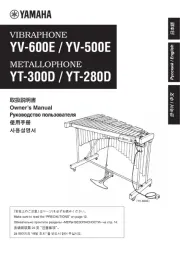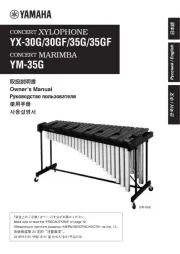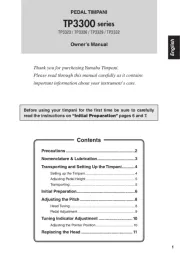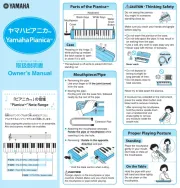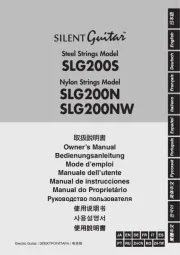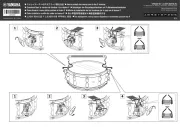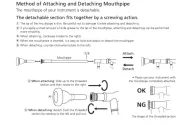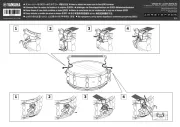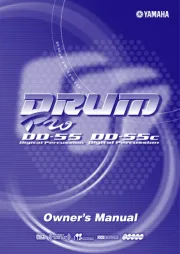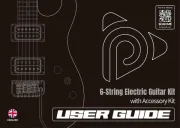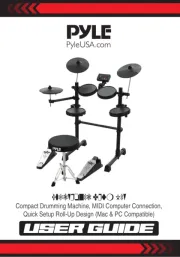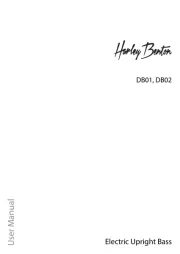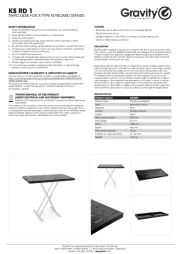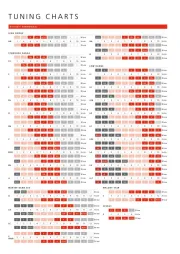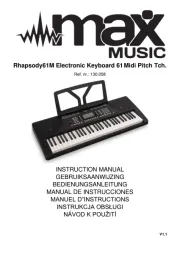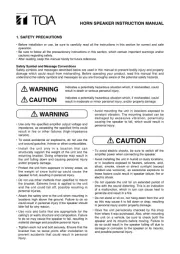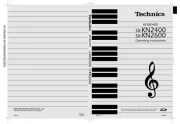
シロフォン / / XYLOPHONE / XYLOPHON / XYLOPHONE高音木琴
取扱説明書 / 使用說明書 / Owner’s Manual /
Bedienungsanleitung / Mode d’emploi
シロフォンを使用する前に、以下の指示と取扱説明をよく読んでください。
シロフォンはご家庭や学校内で、お子様から専門家まで幅広い方々にご愛用いただいております。室内での置き場所や日常の取り扱いについて、
安全にご使用いただくため、下記の注意を必ず守ってください。特に小さなお子様には、最初にご家族の方、または指導者から取り扱い方法を指
導してください。お読みになった後は、使用される方がいつでも見られる所に必ず保管してください。
注意(危険・警告を含む)を促す内容があることを告げるものです。
この「安全へのこころがけ」は製品を安全に正しくお使いいただき、お客様や他の人々
への危害や財産への損害を未然に防止するために、いろいろな絵表示を使って説明して
います。絵表示の意味をよく理解してから、本文をお読みください。
楽器にもたれかかったり、乗ったりしないでください。
身体をぶつけてけがをするおそれがあります。楽器の転倒の原因にも
なります。お子様が楽器のまわりであそばないよう注意してください。
楽器をぐらついた台の上や傾いた所など、不安定な場所に置かないで
市販のスタンドを使用する場合は、スタンドの中心にバランス良く設
この表示を無視して誤った取り扱いをすると、人が死亡又は重傷を
木材に含まれる天然成分の働きによって、音板の表面が白くなることがあ
ります。白くなっても製品の品質や性能には影響しませんが、ふき取るに
この表示を無視して誤った取り扱いをすると、人が障害を負うおそ
※本書は、発行時点での最新仕様で説明しています。最新版は、ヤマハウェブサイトからダウン
Please read the following instructions and explanations on handling before using the xylophone.
The xylophone is an instrument that can be used at school or home by a wide variety of people ranging from children to professional musicians. For
your safety, please observe the following precautions regarding the placement and daily use of the xylophone. Especially in the case of children, a
responsible adult should provide instruction on the proper use and treatment of the xylophone. Please keep this manual in a safe and convenient
place for future reference.
This icon indicates actions that are prohibited.
This icon urges you to use caution (includes dangers and warnings).
This icon indicates instructions that should be strictly followed.
— Obey all precautions described below
Icons are used in this section to promote the safe and proper use of this
product and to prevent harm and property damage to you and others.
Please fully understand the meaning of the icons before reading the
Do not lean against or climb onto the instrument.
The instrument could collapse causing serious injury.
Disregarding the warnings with this mark may result in death or
Transportation/Installation
• Do not place objects on the instrument. Doing so may cause damage to the tone
• Do not strike the tone bars with glockenspiel mallets or any other hard object. Doing
so may dent, damage, or scratch the tone bars. It may also cause the tone bars to
• Use a soft dry cloth or silicon cloth when caring for the tone bars. For grime that
cannot be removed, moisten a soft cloth with a little ethyl alcohol. Never use
thinner, benzene, or a damp cloth. Doing so may harm the coating on the tone bars.
• Cover the instrument with the included Drop cover when not in use to protect the
tone bars from dust. If the Drop cover needs cleaning, please have it dry cleaned.
Due to the action of natural elements in the wood, the surface of the tone bars might
eventually become covered by white powdery residue. This will not affect the quality or
performance of the product. Use a dry cloth to wipe off this residue if it appears.
Do not use the mallets for any other purpose than playing the instrument.
Doing so may cause an accident or injury. Caution children against using mallets
for violence, such as hitting others with them.
Do not play around the instrument.
Running into the instrument may cause bodily injury. It may also cause the
instrument to fall over. Please instruct children to not play around the instrument.
Do not position the instrument on an unstable surface such as an unsteady
Doing so may cause the instrument to drop, fall over, or cause injury.
If you plan to store the instrument for a long period
of time, place it horizontally on a stable surface.
When storing the instrument temporarily in an
upright position, lean the instrument against a
vertical wall, with the bass side down.
Otherwise, the instrument may fall over and be
Disregarding the cautions with this mark may result in personal
• Legen Sie keine Gegenstände auf dem Instrument ab. Dies könnte Schäden an
Klangplatten und Rahmen zur Folge haben.
• Schlagen Sie die Klangplatten nicht mit Glockenspiel-Schlägeln oder anderen harten
Gegenständen an. Dies könnte Dellen, Schäden und Kratzer an den Klangplatten
verursachen. Die Klangplatten können sich dadurch auch verstimmen.
Wischen Sie die Klangplatten zur Pflege mit einem weichen und trockenen Lappen oder
Silikontuch sauber. Bei hartnäckiger Verschmutzung feuchten Sie einen weichen Lappen
mit etwas Äthylalkohol an. Verwenden Sie niemals Verdünner, Benzol oder feuchte
Lappen. Nichtbeachtung kann Schäden an der Klangplattenbeschichtung verursachen.
• Das Instrument bei Nichtgebrauch mit der im Lieferumfang enthaltenen
Schutzabdeckung verdecken, um die Klangplatten vor Staub zu schützen. Die
Schutzabdeckung gegebenenfalls trocken reinigen.
• Ne placez aucun objet sur l’instrument. Cela pourrait endommager les lames
• Ne frappez pas les lames avec des baguettes de glockenspiel ou tout autre objet dur.
Cela pourrait casser, endommager rayer ou désaccorder les lames.
• Utilisez un chiffon doux et sec ou un chiffon de silicone lors de l’entretien des
lames. Pour la saleté qui ne peut pas être retirée, humidifiez un chiffon doux avec un
peu d’alcool éthylique. N’utilisez jamais un diluant, du benzène, ou un chiffon
mouillé. Cela pourrait endommager le revêtement sur les lames accordées.
Couvrez l’instrument avec la housse fournie quand vous ne l’utilisez pas pour protéger
les lames de la poussière. Si la housse est encrassée, faites-la nettoyer à sec.
So vermeiden Sie Unfälle und Verletzungen
— Die nachstehenden Vorsichtsmaßregeln bitte einhalten
Vorsichtsmaßregeln werden durch erläuternde Symbole angezeigt. Sie
sollen einen sicheren und vorschriftsmäßigen Gebrauch fördern und Sie
sowie Andere vor Verletzungen und Sachschäden bewahren. Bitte lesen
Sie die Vorsichtsmaßregeln, nachdem Sie sich mit der Bedeutung der
Symbole vertraut gemacht haben.
Durch dieses Symbol kenntlich gemachte Handlungen sind untersagt
und sollten nicht versucht werden.
Dieses Symbol fordert Sie zur Vorsicht auf (es kennzeichnet Gefahren
Dieses Symbol kennzeichnet Handlungen, die Sie durchführen müssen.
©2023YamahaCorporation
Prévention contre toutes blessures
— Veuillez suivre toutes les précautions ci-dessous
Des icônes sont utilisés dans cette rubrique pour rendre plus claires les
instructions de sécurité permettant d’éviter les risques de blessure et de
dégâts matériels. Veuillez bien lire les consignes et comprendre le sens
de chaque icône avant de lire le reste de ce mode d’emploi.
Cette icône signale des actions interdites.
Cette icône vous invite à la prudence (dangers et avertissements).
Cette icône signale des instructions spécifiques qui doivent absolument
Veuillez lire très attentivement ce manuel d’utilisation avant d’utiliser votre xylophone et conservez-le
précieusement en vue d’une consultation ultérieure.
Le xylophone est un instrument de musique qui peut être utilisé à l’école ou chez soit par une grand variété de personnes, de l’enfant au musicien
professionnel. Pour votre sécurité, veuillez respecter les indications suivantes concernant le placement et l’utilisation quotidienne du xylophone.
Dans le cas d’une utilisation par un enfant, nous recommandons qu’un adulte explique la bonne utilisation et manipulation du xylophone. Rangez ce
manuel en lieu sûr et à portée de main afin de pouvoir le consulter ultérieurement.
けがや事故の原因となります。お子様が人の身体をたたくなど、危険
●楽器の上にものをのせないでください。音板や枠を傷める原因となります。
音板をグロッケン用マレットや、その他の硬いものでたたかないでください。
音板にへこみやキズができたり、音律が狂ったりする原因ともなります。
音板のお手入れには、乾いた柔らかい布やシリコンクロスをご使用くださ
い。汚れが取れないときは、柔らかい布にエチルアルコールを少量含ませて
ご使用ください。シンナーやベンジン、濡れぞうきんなどは絶対に使わない
でください。音板の表面塗装を侵すなど、楽器を傷める原因となります。
●楽器を使用しない場合は、音板をほこりから守るため付属のカバーをかけ
てください。カバーをクリーニングする際はドライクリーニングをご指定
Bitte lesen Sie die nachstehenden Anweisungen und Erläuterungen zur Handhabung, bevor Sie das Xylophon verwenden
Das Xylophon ist ein Instrument, das in der Schule oder zuhause von Personen aller Altersgruppen, von Kindern bis hin zu Profimusikern, verwendet
werden kann. Beachten Sie zu Ihrer Sicherheit bitte die nachstehenden Vorsichtsmaßregeln für die Aufstellung und den täglichen Gebrauch des
Xylophons. Wenn Kinder das Xylophon verwenden, sollte ein verantwortlicher Erwachsener diese in die korrekten Verwendung und Behandlung des
Instruments einweisen. Bitte heben Sie dieses Handbuch an einem sicheren und leicht zugänglichen Ort auf, um später wieder darin nachschlagen
If you choose to use a commercially-available stand, position the instrument
in the middle of the stand to keep it balanced.
Im Holz der Klangplatten enthaltene Naturstoffe können allmählich weiße Pulverrückstände
an der Oberfläche bilden. Dies beeinträchtigt in keiner Weise die Qualität oder Leistung des
Instrumentes. Solche Rückstände können ggf. mit einem trockenen Tuch abgewischt werden.
L’action des éléments naturels du bois pourrait entraîner la formation d’une fine pellicule
de résidu blanc sur la surface des lames. Ceci n’affecte pas la qualité ni les performances
du produit. Éliminez toute trace de ce résidu en frottant avec un chiffon doux et sec.
Lehnen Sie sich nicht an oder auf das Instrument und klettern Sie nicht darauf.
Das Instrument könnte zusammenbrechen oder umkippen und eine schwere
Nichtbeachtung der mit dieser Kennzeichnung versehenen
Warnhinweise kann den Tod oder schwere Verletzungen zur
Vorsicht bei der Handhabung
Verwenden Sie die Schlägel nur zum Spielen auf dem Instrument.
Ein Missbrauch der Schlägel kann Verletzungen und Unfälle zur Folge haben.
Kinder sind vor gewaltsamem Umgang so wie Schlagen mit den Schlägern zu
Dulden Sie keinen Unfug im Bereich des Instruments.
Eine Kollision mit dem Instrument kann eine schwere Verletzung zur Folge
haben. Das Instrument könnte dabei auch umkippen. Achten Sie darauf, dass
Kinder nicht im Bereich des Instruments spielen.
Stellen Sie das Instrument nicht auf einer instabilen Fläche wie einem
unebenen oder schrägen Boden auf.
Dies könnte einen Fall oder ein Umkippen des Instruments zur Folge haben und
Verletzungen verursachen.
Bei längerer Lagerung das Instrument horizontal auf
eine stabile Oberfläche abstellen.
Bei kurzzeitiger Lagerung in aufrechter Lage das
Instrument mit nach unten gerichteter Tieftonseite
an eine senkrechte Wand lehnen.
Andernfalls könnte das Instrument umstürzen und
beschädigt werden oder Verletzungen verursachen.
Die Nichtbeachtung der auf diese Weise gekennzeichneten
Vorsichtshinweise kann zu Verletzungen führen.
Vorsicht bei der Handhabung
Beim Einsatz eines handelsüblichen Ständers das Instrument mittig
anordnen, um es im Gleichgewicht zu halten.
Ne vous appuyez pas et ne grimpez sur l’instrument.
L’instrument risquerait de tomber entraînant des blessures graves.
Ne pas tenir compte des avertissements qui accompagnent
cet icône peut entraîner la mort ou des blessures graves.
Ne pas utilisez les baguettes pour une tout autre utilisation que de jouer sur
Cela pourrait causer un accident ou des blessures. Veillez à ce que les enfants
n’utilisent pas les maillets pour se frapper mutuellement.
Ne jouez pas autour de l’instrument.
Jouer autour de l’instrument peut entraîner des blessures corporelles. Cela
pourrait aussi provoquer la chute de l’instrument. Veuillez dire aux enfants de ne
pas jouer autour de l’instrument.
Ne positionnez pas l’instrument sur une surface instable telle qu’un support
Sinon, l’instrument pourrait tomber, se renverser ou causer des blessures.
Si vous utilisez un pied disponible dans le commerce, placez l’instrument au
milieu du pied pour assurer son équilibre.
Si vous comptez ranger l’instrument pendant une
période prolongée, placez-le en position horizontale
Si vous rangez l’instrument de manière temporaire
en position verticale, posez-le contre un mur, en
plaçant son côté grave en bas.
Sans cela, l’instrument risque de se renverser et de
causer des dommages ou des blessures.
Le non-respect des consignes repérées par ce symbole pourrait
causer des blessures corporelles.
Range C52–C88 (3 Octaves)
Tone Bar Material Pao rosa
Tone Bar Width/Thickness 38 mm (1 1/2") / 21 mm (7/8")
Dimensions 116 × 57 × 14 cm (45 1/2" × 22 3/8" × 5 1/2")
* The contents of this manual apply to the latest specifications as of the publishing date. To obtain
the latest manual, access the Yamaha website then download the manual file.
寸法(間口×奥行×高さ)116×57×14cm
Umfang C52 bis C88 (3 Oktaven)
Klangplattenmaterial Pao rosa
Klangplattenbreite/-dicke 38 mm / 21 mm
Abmessungen 116 × 57 × 14 cm
* Der Inhalt dieser Bedienungsanleitung gilt für die neuesten technischen Daten zum Zeitpunkt der
Veröffentlichung. Um die neueste Version der Anleitung zu erhalten, rufen Sie die Website von
Yamaha auf und laden Sie dann die Datei mit der Bedienungsanleitung herunter.
Plage C52–C88 (3 octaves)
Matériau des lames Pao rosa
Longueur/épaisseur des lames 38 mm / 21 mm
Dimensions 116 × 57 × 14 cm
* Le contenu de ce mode d’emploi s’applique aux dernières caractéristiques techniques connues
à la date de publication du manuel. Pour obtenir la version la plus récente du manuel, accédez
au site Web de Yamaha puis téléchargez le fichier du manuel concerné.
組み立ては必ずシロフォンの取り扱い知識のある方が行ってください。音板のセットは①幹音板、②派生音板の順に行います。高音側と低音側の両端の金属
の吊金に音板つづり紐を引っかけて、音板を押し込むとセットできます。
Assembly must be carried out by someone with knowledge of handling the xylophone. Tone bars must be set in following order,
Natural tone bars first, then
Accidental tone bars. Hook the suspension cord to the posts at both ends of the treble and bass sides and gently place the tone bars on the rails.
Der Zusammenbau des Xylophons sollte von einer fachkundigen Person vorgenommen werden. Die Stammton-Klangplatten müssen vor den 1
Halbton-Klangplatten eingebaut werden. Das Aufhängungsseil an den Pfosten an beiden Enden der Hochton- und Tieftonseite einhaken und die Klangplat-2
ten dann vorsichtig auf die Schienen legen.
Le montage doit être impérativement confié à une personne sachant comment manipuler un xylophone. Les lames doivent être mises en place dans l’ordre
suivant : d’abord les lames des notes naturelles, et 1
ensuite les lames des notes altérées. Accrochez la corde de suspension aux crampons sur les
extrémités du côté grave et du côté aigu de l’instrument, puis mettez les lames en place sur le sommier.
若您選擇使用市售立架,請將樂器架在立架中間使其保持平
Lames des notes naturelles
